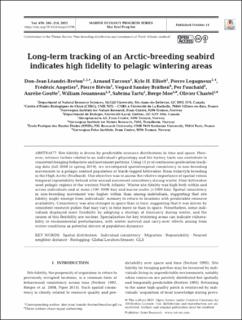| dc.contributor.author | Léandri-Breton, Don-Jean | |
| dc.contributor.author | Tarroux, Arnaud | |
| dc.contributor.author | Elliott, Kyle H. | |
| dc.contributor.author | Legagneux, Pierre | |
| dc.contributor.author | Angelier, Frédéric | |
| dc.contributor.author | Blévin, Pierre | |
| dc.contributor.author | Bråthen, Vegard Sandøy | |
| dc.contributor.author | Fauchald, Per | |
| dc.contributor.author | Goutte, Aurélie | |
| dc.contributor.author | Jouanneau, William | |
| dc.contributor.author | Tartu, Sabrina | |
| dc.contributor.author | Moe, Børge | |
| dc.contributor.author | Chastel, Olivier | |
| dc.coverage.spatial | Svalbard | en_US |
| dc.date.accessioned | 2022-03-25T11:00:22Z | |
| dc.date.available | 2022-03-25T11:00:22Z | |
| dc.date.created | 2021-10-29T13:29:47Z | |
| dc.date.issued | 2021 | |
| dc.identifier.citation | Marine Ecology Progress Series. 2021, 676 205-218. | en_US |
| dc.identifier.issn | 0171-8630 | |
| dc.identifier.uri | https://hdl.handle.net/11250/2987613 | |
| dc.description.abstract | Site fidelity is driven by predictable resource distributions in time and space. However, intrinsic factors related to an individual’s physiology and life-history traits can contribute to consistent foraging behaviour and movement patterns. Using 11 yr of continuous geolocation tracking data (fall 2008 to spring 2019), we investigated spatiotemporal consistency in non-breeding movements in a pelagic seabird population of black-legged kittiwakes Rissa tridactyla breeding in the High Arctic (Svalbard). Our objective was to assess the relative importance of spatial versus temporal repeatability behind inter-annual movement consistency during winter. Most kittiwakes used pelagic regions of the western North Atlantic. Winter site fidelity was high both within and across individuals and at meso (100-1000 km) and macro scales (>1000 km). Spatial consistency in non-breeding movement was higher within than among individuals, suggesting that site fidelity might emerge from individuals’ memory to return to locations with predictable resource availability. Consistency was also stronger in space than in time, suggesting that it was driven by consistent resource pulses that may vary in time more so than in space. Nonetheless, some individuals displayed more flexibility by adopting a strategy of itinerancy during winter, and the causes of this flexibility are unclear. Specialization for key wintering areas can indicate vulnerability to environmental perturbations, with winter survival and carry-over effects arising from winter conditions as potential drivers of population dynamics. : Spatial distribution · Individual consistency · Migration · Repeatability · Nearest neighbor distance · Biologging · Global Location Sensors · GLS | en_US |
| dc.language.iso | eng | en_US |
| dc.rights | Navngivelse 4.0 Internasjonal | * |
| dc.rights.uri | http://creativecommons.org/licenses/by/4.0/deed.no | * |
| dc.subject | Spatial distribution | en_US |
| dc.subject | Individual consistency | en_US |
| dc.subject | Migration | en_US |
| dc.subject | Repeatability | en_US |
| dc.subject | Nearest neighbor distance | en_US |
| dc.subject | Biologging | en_US |
| dc.subject | Global Location Sensors | en_US |
| dc.subject | GLS | en_US |
| dc.title | Long-term tracking of an Arctic-breeding seabird indicates high fidelity to pelagic wintering areas | en_US |
| dc.type | Peer reviewed | en_US |
| dc.type | Journal article | en_US |
| dc.description.version | publishedVersion | en_US |
| dc.rights.holder | © 2021 The Authors | en_US |
| dc.subject.nsi | VDP::Zoologiske og botaniske fag: 480 | en_US |
| dc.subject.nsi | VDP::Zoology and botany: 480 | en_US |
| dc.source.pagenumber | 205-218 | en_US |
| dc.source.volume | 676 | en_US |
| dc.source.journal | Marine Ecology Progress Series | en_US |
| dc.identifier.doi | 10.3354/meps13798 | |
| dc.identifier.cristin | 1949660 | |
| dc.relation.project | Norges forskningsråd: 310662 | en_US |
| cristin.ispublished | true | |
| cristin.fulltext | original | |
| cristin.qualitycode | 2 | |

